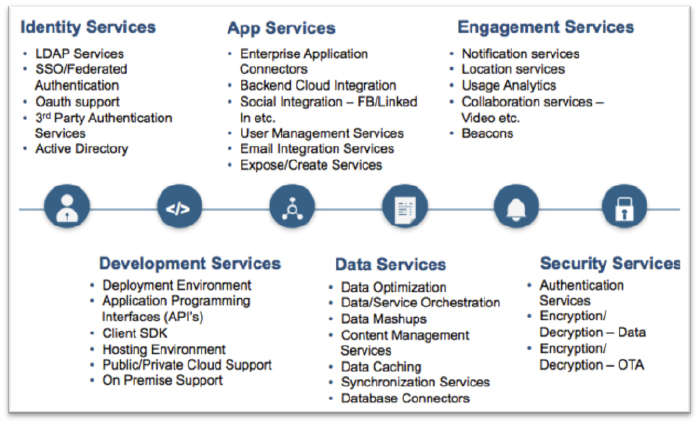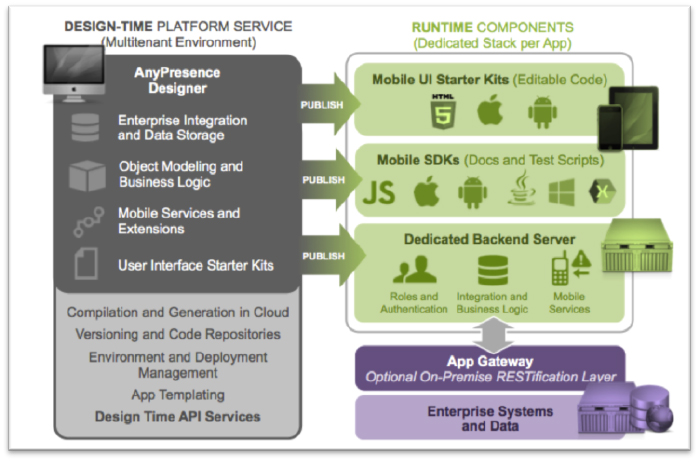Last week, Harsha Avvari, Head of Technology at Cognizant Technology Solutions and Rich Mendis, Chief Product Officer at AnyPresence joined forces to present their view of the future of enterprise architecture in the digital world. This is a summary of their web session.
As the technology landscape evolves at a dramatic pace driven by cloud software services and smart device proliferation, companies are struggling to keep up with the pace of innovation and its exponential complexity. As the post-PC era matures, new web-connected devices such as appliances, wearables, automobiles and other non-traditional channels are emerging. It is imperative for enterprises to enable their developer ecosystems with the appropriate digital infrastructure if they are to take advantage of the opportunities these new channels offer and remain relevant.
- The App Development Challenges
Short development cycles: Development cycles need to be shorter and more frequent in order to keep pace with expectations. End-user expectations are formed by their experiences with consumer apps and services that innovate rapidly, and companies must respond by adjusting the pace of enterprise technology match this pace.
Complexity growing across the board: Budgets are not increasing to cover the additional complexity of cross platform development. The cost of building enterprise multi-channel apps are further underestimated due to the outdated reference architectures, and a lack of strategic investment in backend services infrastructure.
Budgets not readjusted accordingly: As devices continue to be released with a variety of form factors and capabilities, each one brings a new set of requirements and limitations that needs to be addressed. Complexity increases across both client and server side areas, with strong emphasis on secure and scalable infrastructure. - Traditional Web Architecture Challenges
Isolated view of the end-user: The enterprise view of the customer or user is limited to a specific line of business or application function, and does not take into account a holistic approach of the user’s overall needs.
Limited actionable insights: Application designs are driven by the data structure rather than through predicting or analyzing the actual needs of the users.
Change Management is difficult: Uncovering and implementing users’ requirements will have to be part of a larger, cross-functional effort and is more time consuming. - The Device Challenge
Less uniform capabilities: As end-user devices become increasingly varied, they take on any form and shape, with high degrees of variability in computing power, screen size, interaction modes, and specialized functions.
(the real) Power user: User is now in charge and decides if and when to engage with the app, and how to engage with the app based on the device interaction paradigm. Engagement is a key challenge.
Contextual delivery: Users are expecting to see contextualized information based on their location or on notifications.
Exponential security threat: More channels and apps exponentially multiply the security threat as well as their complexity.
Related: The Native Mobile Apps: Reports of My Death Have Been Greatly Exaggerated - Key Components of the Enterprise Digital Architecture
User Context Base Engagement: Users or customers are being served information and functionality relevant to their current situation and needs.
Optimized User Interface (UI): The UI is optimized to each channel available to the users to make the best use of the device capabilities and form factor.
Profile building: Digital footprint is captured at every step of the engagement to complement the user profile and in the spirit of continuous improvement.
Predictive capability: By capturing user preferences and behaviors, future needs can be anticipated for faster response time and better services. - Key capabilities of the Enterprise Digital Architecture:

Mobile Backend Services or MBaaS: is the ideal digital infrastructure solution to tackle these challenges and prepare your enterprise for this exciting new landscape. MBaaS helps solve the challenges of the Digital enterprise architecture by providing:
- App development Acceleration: Typically, app developers spent around 60% of their time building what is happening behind the user interface. On the backend side, they need to build the integration to the various backend services, expose existing APIs or create an abstraction layer on top of the APIs or ASP to make it easier for the mobile developers to consume the data. Then, on the front end, they need to handle data caching, objects creation and management, data parsing and more. Those tasks considerably extend the mobile app development lifecycle. An MBaaS will help dramatically shrink the time to setup all the backend integration and orchestration across the diverse data sources as well as defining the modeling layer on the client side. And during the iteration and maintenance phase, it will continue to facilitate the app management and updates and consequently reduce the TCO for each app.
Based on our past implementations, AnyPresence customers experience on average a 4 to 5-fold reduction on their initial development time. - Consistent Experience across Devices and Apps: An MBaaS provides a clean set of web services that exposes operations on top of the enterprise legacy systems, enterprise applications and any existing custom services. An MBaaS layer enables your enterprise to create app specific business logics that may cut across different backend systems. For instance, user roles and access can be defined in the context of an app and doesn’t have to live in one of those backend systems. As a result, data are better protected; apps are more secure and relevant to the user and the front-end interface tailored to specific endpoint format provides a consistent and positive experience to the end user.
- Data Security: IT sometimes is more in the service role where they are enabling other line of business in the company to build apps. Data access and security remains one of their prime concerns. This framework enables IT to standardize how access is provided to the enterprise backend systems and even adds value to the development process by providing an SDK to the line of business developers. Each group across the enterprise can then build their own apps using their tools of choice while IT knows that enterprise data and systems are secure and efficient.
AnyPresence Solution Overview:
Below is an overview of the AnyPresence solution:

To learn more about AnyPresence MBaaS Platform and how it can help, you can contact us.
You can also watch the full webinar here. - App development Acceleration: Typically, app developers spent around 60% of their time building what is happening behind the user interface. On the backend side, they need to build the integration to the various backend services, expose existing APIs or create an abstraction layer on top of the APIs or ASP to make it easier for the mobile developers to consume the data. Then, on the front end, they need to handle data caching, objects creation and management, data parsing and more. Those tasks considerably extend the mobile app development lifecycle. An MBaaS will help dramatically shrink the time to setup all the backend integration and orchestration across the diverse data sources as well as defining the modeling layer on the client side. And during the iteration and maintenance phase, it will continue to facilitate the app management and updates and consequently reduce the TCO for each app.